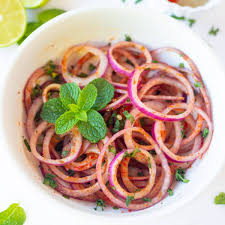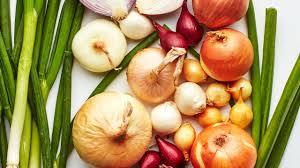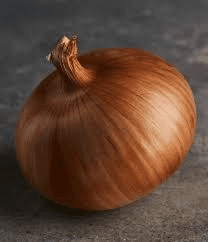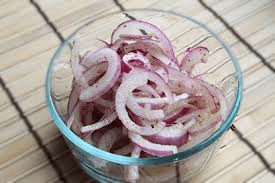Onion style is a term often used to describe the layers and structure of an onion, both in its physical form and metaphorically to explain complexity in various contexts.
An onion, belonging to the genus Allium, is a widely cultivated vegetable known for its pungent aroma and multiple layers. Each onion consists of several concentric layers, starting from the outer skin, which is usually papery and thin, to the inner fleshy layers that are edible. This layered structure is a result of the onion’s growth process, where new leaves form and wrap around each other as the onion bulb develops underground.
The outermost layer of an onion, often dry and papery, serves as a protective cover for the inner, more delicate layers. These layers are designed to protect the onion from physical damage, dehydration, and pests.
Beneath this outer skin, the layers become thicker and more succulent. Each of these fleshy layers is actually a modified leaf, which stores water and nutrients for the plant. The innermost part of the onion is the core, which is the youngest part of the bulb and often the most tender.
Scientifically, the onion’s layered structure is an example of a tunicate bulb, characterized by concentric layers of fleshy leaves. This structure allows the onion to be a resilient and robust plant, capable of surviving in various environments.
Onions are biennial plants, meaning they typically take two years to complete their life cycle. In the first year, they grow from a seed into a bulb. If left in the ground, they will sprout again in the second year, produce flowers, and then go to seed.
The layered anatomy of onions also has a fascinating biochemical aspect. Onions contain a variety of sulfur-containing compounds, such as sulfoxides, which are responsible for their distinctive smell and taste.
When an onion is cut, these compounds are released and converted into volatile gases that can irritate the eyes and cause tearing. This is a defense mechanism evolved by the plant to deter herbivores from eating it.
Onion style, in a broader metaphorical sense, can be applied to describe complex systems or processes that have multiple layers or levels of depth. For instance, in literature and analysis, peeling back the layers of a story or concept can reveal deeper meanings and insights. Similarly, in computer science, onion style might refer to data encryption techniques, where information is encrypted in multiple layers for added security.
The nutritional value of onions adds another dimension to their scientific interest. Onions are low in calories but rich in vitamins, minerals, and antioxidants. They contain vitamin C, vitamin B6, folate, and potassium. Onions also have compounds that have been shown to have anti-inflammatory, antioxidant, and anticancer properties. Regular consumption of onions can contribute to overall health and may help in reducing the risk of certain diseases.
In agricultural science, the cultivation of onions involves understanding their growth requirements, such as soil type, water needs, and climate conditions. Onions thrive in well-drained soil with plenty of organic matter.
They prefer cool weather during their early growth stages but need warm conditions for bulb formation. Proper management of pests and diseases, such as onion fly and fungal infections, is crucial for a successful onion harvest.
Onion style encapsulates the physical, biochemical, and metaphorical layers associated with onions. From their concentric layered structure, which serves multiple protective and nutritional functions, to their broader application in describing complexity, onions are a fascinating subject of study in both botanical and metaphorical contexts.
Their layered nature, pungent compounds, nutritional benefits, and agricultural significance make them an integral part of both our diets and our understanding of plant biology.
The Economic Importance and Uses of Onion Style

1. Culinary Use: Onions are a staple in many dishes around the world, providing flavor and texture. Examples include French onion soup and caramelized onions in burgers.
2. Medicinal Use: Onions have antibacterial and anti-inflammatory properties. They are used in home remedies for colds and coughs.
3. Preservative: Onions can be used to preserve food. For example, onion powder is used in packaged snacks to extend shelf life.
4. Agricultural Use: Onions are used as a natural pesticide in gardens to repel insects.
5. Flavoring Agent: Onion extracts are used in sauces, dressings, and marinades to enhance flavor.
6. Nutritional Supplements: Onion extracts are used in dietary supplements due to their high antioxidant content.
7. Skincare Products: Onion juice is used in skincare products for its potential to reduce scars and improve skin texture.
8. Hair Care: Onion juice is believed to promote hair growth and is used in hair masks and oils.
9. Biofuel Production: Onion waste can be converted into biofuel, providing an eco-friendly energy source.
10. Animal Feed: Onion peels and scraps can be used as a supplement in animal feed, providing nutrients to livestock.
11. Fertilizer: Onion waste can be composted to create nutrient-rich fertilizer for crops.
12. Antimicrobial Agents: Onion extracts are used in natural antimicrobial agents for food preservation and hygiene products.
13. Dye Production: Onion skins can be used to create natural dyes for textiles and Easter eggs.
14. Traditional Medicine: Onions are used in various traditional medicines around the world to treat ailments such as earaches and wounds.
15. Packaging Material: Onion skin fibers are being researched as sustainable packaging materials.
16. Culinary Arts: Onions are used in culinary education to teach cutting techniques and flavor balancing.
17. Economic Crop: Onions are a significant cash crop for many farmers, contributing to local and national economies.
18. Culinary Competitions: Onions are featured in culinary competitions, promoting creativity and culinary skills.
Read Also: Factors that Determine the Amount of Wind Erosion
The Products and By-products That Can Be Derived From Onion Style

1. Onion Powder: Made by dehydrating and grinding onions, used in cooking and seasoning.
2. Onion Flakes: Dehydrated onion pieces used in soups and stews.
3. Onion Oil: Extracted from onions, used in flavoring and aromatherapy.
4. Onion Juice: Used in culinary dishes and home remedies.
5. Onion Paste: A blended form of onions used in sauces and marinades.
6. Onion Extract: Used in supplements and cosmetics for its antioxidant properties.
7. Onion Soup Mix: A powdered mix used to make instant soup.
8. Pickled Onions: Onions preserved in vinegar, used as a condiment.
9. Fried Onions: Crispy onions used as toppings for dishes.
10. Onion Salt: A blend of onion powder and salt, used for seasoning.
11. Onion Bread: Bread flavored with onion, often used for sandwiches.
12. Onion Rings: Deep-fried onion slices served as appetizers.
13. Onion Dye: Natural dye made from onion skins, used in textiles.
14. Onion-Based Biofuel: Biofuel produced from onion waste.
15. Onion-Based Animal Feed: Nutrient-rich feed made from onion by-products.
16. Onion Compost: Compost made from onion waste, used as fertilizer.
17. Onion Skincare Products: Creams and lotions containing onion extracts for skin benefits.
Read Also: 21 Medicinal Health Benefits Of Diospyros seychellarum (Seychelles Ebony)
Frequently Asked Questions (FAQ’s) About Onion Style

1. What are the health benefits of onions? Onions have antibacterial, anti-inflammatory, and antioxidant properties, which can boost immunity and improve overall health.
2. How can I use onions in cooking? Onions can be used in a variety of ways, including sautéing, caramelizing, roasting, and as a raw ingredient in salads.
3. Are onions safe for pets? Onions are toxic to pets, especially dogs and cats, and should be avoided in their diet.
4. How should I store onions? Onions should be stored in a cool, dry place with good ventilation, away from potatoes.
5. Can onions help with hair growth? Onion juice is believed to promote hair growth and is used in some home remedies and hair care products.
6. What are the different types of onions? Common types of onions include yellow, red, white, and green onions, each with unique flavors and uses.
7. How do I reduce onion tears while cutting? Chilling the onion before cutting or cutting under running water can help reduce tears.
8. Can I use onions as a natural pesticide? Yes, onion extracts can be used to repel insects in gardens.
9. What is the nutritional value of onions? Onions are low in calories but rich in vitamins C and B6, folate, potassium, and antioxidants.
10. How are onions used in traditional medicine? Onions are used in traditional medicine to treat various ailments, including colds, earaches, and wounds.
Read Also: Benefits of Passion Flowers

